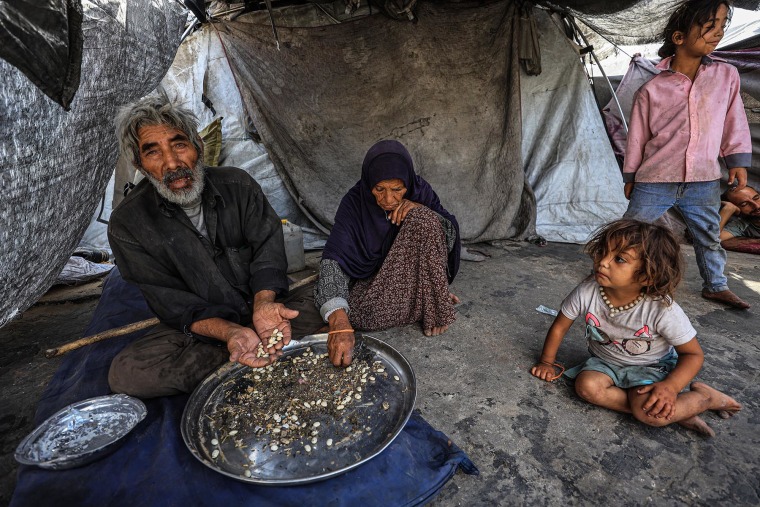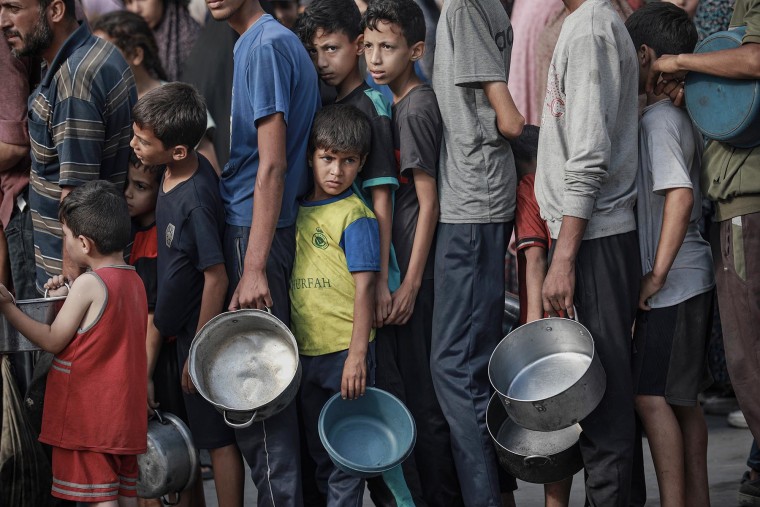As deaths from starvation in the Gaza Strip continue to rise, experts say there’s no easy way out of the crisis due to the medical complexity of treating severe malnutrition.
More than 160 people — at least 90 of them children — have died of malnutrition since the war began, according to Gaza’s Health Ministry.
The world’s leading body on hunger, the Integrated Food Security Phase Classification (IPC), says that nearly all of Gaza is suffering a food security crisis or worse, and more than half of the population is in the “emergency” or “catastrophe” phase of starvation — which means recovering isn’t as simple as giving starving people food.
Rather, giving food to people experiencing such an extreme degree of starvation could kill them, experts say.
“If you do what the body wants to do, which is to just drink and eat as much as possible the minute you see food, you can actually create these permanent imbalances that can cause things like heart failure or organ damage, because the body had to adapt to get to that starvation mode,” NBC News medical contributor Dr. Kavita Patel, an internal medicine doctor, said.
At the most severe stages of starvation, even giving a person water can push their body into failure, Patel said.
What happens to the body when it’s starving?
Humans can generally go without any food or water for several days because the body finds a way to adapt in order to survive. First by feeding off of so-called glycogen stores — a starchy substance from carbohydrates that’s stored in the liver and muscles. The body stores about 1,700 to 2,200 calories’ worth of energy as glycogen.
“That’s the first thing your body goes for that can get you through without eating or any water for about several days, in some cases, maybe a little longer,” Patel said.
Once those glycogen stores are depleted, the body starts to break down fat for energy, but when that’s gone, it turns to muscle. This is what causes the body to shrink and the starving person to assume a gaunt, hollow-cheeked look.Eventually the brain doesn’t have the energy it needs to function, leading to irritability, mood swings and trouble concentrating.
“It’s very hard to even just make sound judgments,” Patel said. “You can see people have psychotic illusions. You can see people hearing things. All of that is basically the body’s way of surviving.”
Most starving people die from infections as their immune system shuts down. Eventually, the heart will be affected, causing a person’s blood pressure and pulse to drop. If they don’t die from infection, the heart will shut down, doctors said.
The more vulnerable parts of the population are likely to suffer the most. “Children — specifically infants — pregnant women, the elderly and people with certain kinds of chronic illness are the risk groups that we need to pay special attention to,” said Dr. Irwin Redlener, a clinical professor of pediatrics at the Albert Einstein College of Medicine in New York City.
How is starvation treated?
Patel said a good analogy to giving food to a starving person is a downpour after a drought. The land desperately needs water, but because it’s so dry it repels water instead of absorbing it, leading to flash flooding. “Refeeding” after starvation needs to be managed clinically and by medical professionals.
“When a person has reached a state of starvation, the body undergoes extreme metabolic changes,” she said. “Giving too much food — or the wrong kind — too quickly can trigger a dangerous shift in fluids and electrolytes known as refeeding syndrome, which can be fatal if not carefully managed.”
“A bag of flour — some of the only food aid that has gotten in recently — won’t save anyone because it has none of the essential nutrients,” said Dr. Nour Alamassi, a doctor and the medical team lead for Project HOPE, an international nongovernmental organization focused on global health and humanitarian aid.
“Too many carbs can actually be life-threatening for anyone with Severe Acute Malnourishment (SAM), and even for the average person in Gaza who has not had a regular diet in many months, it is very difficult to digest,” Alamassi, who is caring for children and pregnant women in Gaza, wrote in an email.

Ideally, doctors told NBC News, there would be enough medical staff to monitor the refeeding process for each person for a period stretching from weeks to even months. Children would be stabilized with fortified milks, which contain the nutrients that a malnourished child needs, and something called ready-to-use therapeutic foods (RUTF), which are energy-dense, easy to digest and carefully balanced in the nutrients children need to start to recover. Doctors would draw blood to monitor sodium and potassium levels — if these electrolytes are too low or too high, it can be deadly.
But the situation on the ground in Gaza is far from ideal. There are not enough doctors, not enough supplies and not the right supplies, experts say.
“The aid blockade has prevented us from accessing the medications and nutrition supplies that are necessary to treat these people,” Alamassi said. “We recently ran out of High Energy Biscuits (HEB) in our clinics, which really limits our ability to help patients. We hope to get more in the coming days, but each day without these supplies can make a major difference for a patient’s outcome.”
What are the long-term effects of starvation?
Even if refeeding is successful, people who survive starvation can experience physical and psychological effects for the rest of their lives, experts said. The damage, especially for young and very old victims, is permanent.
In children, malnutrition can cause delays in both physical and cognitive development. Physically, they’re more likely to have weakened immune systems, leading to a harder time recovering from infections. Malnourished children are also more likely to experience stunted growth, which can affect their height, muscle mass and bone density and even delay puberty, experts said.
Cognitively, children can suffer from permanent brain damage due to iron and zinc deficiencies, affecting their ability to learn and problem solve.

Alamassi said the hunger crisis in Gaza is affecting “an entire generation of children who will suffer lifelong consequences.”The recovery of adults from very severe malnutrition is not only possible, but likely, Redlener said.
“If it’s done right, most adults, unless they’re really at a terminal stage of undernutrition, the refeeding will result in restoration of everything — a far different story than the ability for a young child with prolonged malnutrition, where it’s often impossible to get a full recovery,” he said.
Patel said even people with a history of malnutrition are monitored over years to make sure their bodies are functioning properly.
“As they age and develop, different parts of the body pull on memories of that nutrition depletion,” she said. “So the question we all have to ask ourselves is, how long are we going to be able to do this without having adequate support on the ground?”


